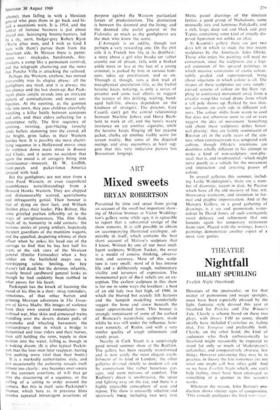ART
Mixed sweets
BRYAN ROBERTSON
Prevented by time and space from giving an account of the small but important show- ing of Matisse bronzes at Victor Wadding- ton's gallery some while ago, it is agreeable to report that a substantial vestige of the show remains. It is still possible to obtain an accompanying illustrated catalogue, ad- mirable in itself, which contains the best short account of Matisse's sculpture that I know. Written by one of our most intel- ligent sculptors, William Tucker, the essay is a model of concise thinking, observa- tion, and accuracy. Most of this sculp- ture is very small: most of it has intense life and a deliberately rough, rudimentary vitality and terseness of expression. The monumental pair of Back reliefs are an ex- ception. The earliest sculpture in this show is for me in some ways the loveliest: a bust of an old lady two feet high, of 1900, in which the blurred but acutely felt features and the lumpish modelling wonderfully suggest the bone and sinew beneath the outer approximated form. This bronze is strongly reminiscent of some of the earliest of Brancusi's naturalistic sculpture, made whilst he was still under the influence, how- ever remotely, of Rodin, and with a very similar quality of tough refinement and sturdy grace.
Nearby in Cork Street is a surprisingly good mixed summer show at the Redfern. The gallery has been recently transformed and is now easily the most elegant estab- lishment of its kind in London: the other galleries devoted strictly to modern art are by comparison like rather luxurious gar- ages, and seem nervous of comfort. The Redfern's decor is unobtrusive, the space and lighting easy on the eye, and there is a highly enjoyable atmosphere of ease and repose. The show is unusually selective and spaciously hung, including two very rare Matta pastel drawings of the nineteen fprties, a good group of Nicholsons, some unusually airy and luminous Poliakoffs, and a rich, large, deep red and black and grey Tapies. containing some kind of ritually dis- posed figuration not unlike an altar.
At Kasmin's gallery there are just two days left in which to study the two recent sculptures by the American, Jules Olitski. Those who enjoy his painting will need no conversion, since the sculptures are a logi- cal extension of his sprayed paintings in which massive saturations of exotic colour, subtly graded and superimposed, bring about situations in which colour is all. The shapes of these sculptures are very simple: cursed screens of colour on ffic floor rip- pling in contrasted movement away from a circular ramp-like raised drum, from which a tall pole shoots up, flanked by two thin- ner columns on each side in different col- ours. The colour shifts from warm to cool but does not otherwise seem to aid or even suggest the idea of movement. Something odd about these sculptures defies histor- ical placing.: they are faintly reminiscent of Russian art in the early years of the cen- tury when constructivism was tempered with cubism, though Olitski's intentions are doubtless wholly different in his attempt to make a kind of non-sculpture—non-phy- sical, that is, and insubstantial—which might serve purely as a vehicle for the movement and interaction and arresting pauses of colour.
In several galleries this summer, includ- ing Leslie Waddington's, there are a num- ber of drawings, recent in date, by Picasso which have all the old mastery of line, wit. throwaway eroticism, and invention in for- mat and graphic improvisation. And at the Mercury Gallery, in a good gathering of drawings, is a sea and promenade water- colour by David Jones, of such astringently sweet delicacy and refinement that one laments again his temporary retirement from view. Placed with the writings, Jones's paintings demonstrate another aspect of a most rare genius.


































 Previous page
Previous page